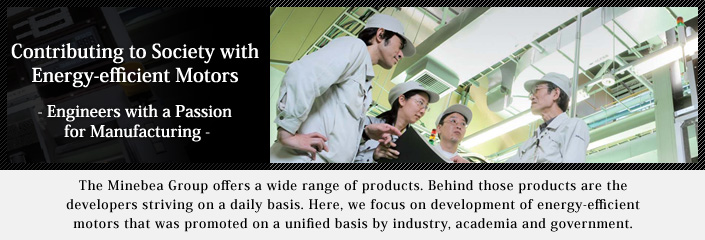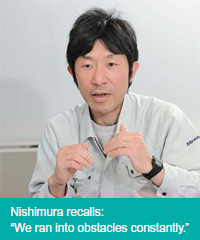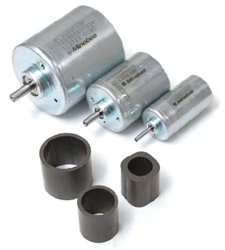2011

(Posted Sept. 2011)
The team's strength and each member's trial and error opened the path to success
 Four new members were assigned to the development team to further the now NEDO-designated project. One of them, Shinsaku Nishimura, recalls that "It felt extremely fulfilling to be involved with the development of such advanced technology."
Four new members were assigned to the development team to further the now NEDO-designated project. One of them, Shinsaku Nishimura, recalls that "It felt extremely fulfilling to be involved with the development of such advanced technology."
Meetings involving the entire team were held approximately once a week. The rest of each member's time was spent in single-minded, repeated experimentation related to the research problem for which he or she was responsible, and day after day, research results accumulated. "To control the magnetic flux, we had to repeatedly experiment with variations in the shape and angle of the magnet, as well as minute variations in the location of the N- and S-poles and the angle of the magnetic flux. But since the magnetic flux we are controlling is invisible, it was very difficult to achieve the results we anticipated. We also ran into obstacles constantly," says Nishimura.
Furthermore, as a NEDO-designated project, the deadline and goals were clearly defined in advance. In addition to the heavy burden of responsibility involved in using taxpayer money, there was also the possibility that support could be terminated before the deadline if the development progress or prospects were poor. Unlike in conventional development projects, the pressure of time and responsibility weighed heavily on the shoulders of each member.
The team members' abundant creativity overcame these challenging circumstances and pushed the project forward. "Even at night when I was at home in bed, when some sort of idea occurred to me, I wanted to go to work and test it. I couldn't wait till morning," says Yamashita with a laugh. Every member was constantly looking for new ideas and turning them into action. Recalls Yamashita, "If we tried something and it didn't work, we came up with the next idea. If that didn't work, then the next. The important thing was to come up with second and third approaches and keep up the fight."
Osamu Kobayashi, a member who handled overall administration for the group, adds that "even with one goal, there may be an unlimited number of ways to reach it. Yamashita has always been a tremendous idea man, and the other members, with much more limited career experience, had a strong determination to reach the goal, and they joined with Yamashita in coming up with ideas."

The advanced bond magnets developed by the team (foreground) and motors planned for future development (rear).
Moreover, researchers in the collaborating academic institutions —Tohoku, Osaka, and Nagasaki Universities and the Shizuoka Institute of Science and Technology— acted as strong partners in supporting the team's efforts. Prior to NEDO designation, at a stage before the project's direction was finalized, the academic researchers participated in meetings and had numerous discussions with the research team members. After the project was under way, they handled basic technological verification and development tasks, including verification of the mechanism of magnetic force reduction and characterization of physical properties of raw magnetic powder, and provided valuable information.
"Sometimes when our opinions differed, they came and stayed overnight in our research lab so we could discuss. At any rate, we worked hard to absorb all of their knowledge, and the two sides greatly stimulated each other. I think we built a relationship where we can work together to promote research and development whenever needed, not just on this project," notes Yamashita.














